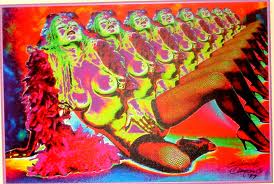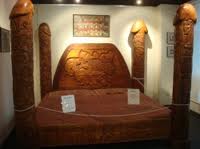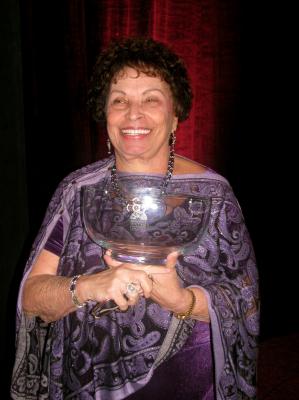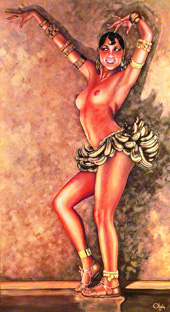“Do not cede your desire" – Jacques Lacan
"Desire is a gift in life” – Chris Corner (IAMX)
The World Erotic Art Museum in Miami Beach, Florida, is a brilliant study in desire as well as an implicit deconstruction of the opposition between pornography and art. My recent visit there thus not only provided me with much food for thought and aesethetic enjoyment, but certainly tickled my loins. The WEAM (yes, even the acronym for the joint sounds suspiciously erotic) has captured the hearts not only of Floridians, but art-lovers from all around the world as well, so I'd love to have the pleasure of sharing my experience of the museum with you.

Image Credit: World Erotic Art Museum
The first thing one notices about the WEAM is its location. Hidden away on the second floor of its respective building, the WEAM can be easy to miss, but I think this stands as key to its role as part of Miami Beach’s cultural unconscious—i.e., as images of 1,000 “competing” desires tucked away from apparent view. One ascends to the WEAM in a rickety elevator and finds oneself in the gift shop suddenly surrounded by erotic books, t-shirts, postcards, and piggy banks made to look like sperm cells. After sheepishly paying the $15 to enter, the thought occurs: “Just how trashy is this place going to be?” But within seconds after entering the exhibits, any notion that the WEAM is less than a collection of artistic genius is thoroughly dashed.

Image Credit: World Erotic Art Museum
Nothing overcomes the idea that the WEAM is reducible to a pornographic peep show more than its septuagenarian collector and curator, Naomi Wilzig, whom I had the pleasure of meeting during my visit. Wilzig, who has been putting together the WEAM’s collection for the past twenty years, is a grandmother whose professional accomplishments have spanned a lifetime. She quietly moves through the museum thinking and observing, seemingly quiet and demure. However, discussing Wilzig’s collection or its purpose with her quickly reveals a fierce, uncompromising intellect and a vision to match it. In Wilzig's words, “[the WEAM is] an education and it’s an awakening that we all are sexual beings, in case you didn’t notice it, or didn’t remember it, or didn’t know it. And that the human body and sexual acts shouldn’t be forbidden but brought out into the open in their honesty and in their purity and in the fact that it expresses the love that people have for each other.”

Image Credit: World Erotic Art Museum
The range of Wilzig’s collection itself is massive, so it's not surprising that my own journey through the WEAM took nearly three hours. Rather than dryly recounting everything that one can find there, let me share my impressions instead. I remember the mythologies of Adam and Eve as well as Leda and the Swan depicted in dozens of stunning ways. I remember works both praising and condemning Lady Godiva and Katherine the Great. I remember Zeus and his many loves surrounded by, appropriately enough, ancient Roman sex toys and figurines. And as I reached the museum’s “center,” I remember the impressive cultural range of the collection with its pieces from Africa and Indonesia, China, Japan, Mexico, France, and more, including contemporary pieces from “masters” such as Picasso and Klimt. There is also a large collection of wooden carvings, furniture, and body casts; photos of pin-up girls, Josephine Baker, and Marilyn Monroe; a bevy of erotic images hidden in almost every household object imaginable; fetish art; lesbian, gay, and bisexual photographs, and much more. Near the exit one can even find the infamous phallic murder weapon from the film A Clockwork Orange.
.jpg)
Image Credit: World Erotic Art Museum
It is a serious understatement to say that the WEAM provides a lot for a theorist of desire to ponder. For example, that the museum is called the World “Erotic” Art Museum rather than the “Sexual” Art Museum aligns its aims with the Foucauldian view that “sexuality” and the categories of sexual identity are fairly recent inventions, whereas the erotic exchanges between bodies and pleasures are much "older." Moreover, with a keen eye one can discern histories of desire and histories of sexuality being produced as one builds narratives while traversing through the museum. These histories of desire and sexuality not only teach one something about history (that it is indeed produced), but also provide a philosophical hammer with which one can smash seemingly intractable notions about what constitute “proper” or “moral” or “correct” desires today. However, while traversing the museum one may also feel the Foucauldian worry concerning the monitoring of desire, that is, by “liberating” our desire and making it visible and public that we simultaneously open it to normative surveillance and control.

Image Credit: World Erotic Art Museum
There is also a fascinating rhetoric operating throughout the WEAM’s collection, making it difficult to tell whether the vocabularies employed are being used euphemistically, for the purposes of academic legitimization (e.g., the word “tumescent” is used innumerable times), or something else altogether. One also gets the wonderfully dizzying impression that the collection is amassed independently of a morally-judgmental eye, that is, one finds images of erotic encounters of all kinds and between all types of beings (i.e., not only hetero-normative and anthropo-normative images). One thus feels as though the WEAM is a space where flows of desire can operate in a more unfettered fashion, where desiring-machines are increasingly capable of “hooking up” and sharing affects as well as bodily fluids (N.B., the museum contains particularly large restrooms hidden away in the rear of the exhibits).
.jpg)
Image Credit: World Erotic Art Museum
Perhaps what I’m suggesting, then, is that the WEAM operates in accordance with an Lacanian/Deleuzian ethics of desire, an ethics where desire is allowed to breathe, rather than attempting to eliminate or yolk it. The museum challenges us to ask whether we have acted in conformity with our desire as part of an ethical life, and challenges us to consider what explosive effects follow when desire (and/as the unconscious-nonconscious) is problematically and systematically bridled. The WEAM also asks us to consider what it is possible for us to do with our bodies, and to consider the range of experience and experiments that a body is capable of (that is, the museum asks us to confront not only the organs of our bodies, but also our bodies without organs). In sum, the museum relentlessly demands that we come to see ourselves as desiring beings, ones that produce desire in response to the call of living. Indeed the WEAM calls us to see immanent life itself as the unfolding and striving of desire.
.jpg)
Image Credit: World Erotic Art Museum
So if you’re ever in Miami Beach, check out the WEAM. Let it call you into the problem-questions of art and desire. And while you’re at it, don’t be afraid of that stirring in the loins. It’s all part of the experience. We swear that it won’t affect your vision or the hairiness of your palms…



.jpg)

.jpg)
.jpg)
Recent comments
2 years 29 weeks ago
2 years 44 weeks ago
2 years 44 weeks ago
2 years 50 weeks ago
3 years 4 weeks ago
3 years 4 weeks ago
3 years 4 weeks ago
3 years 6 weeks ago
3 years 6 weeks ago
3 years 6 weeks ago